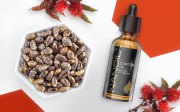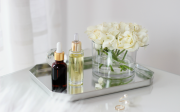Bhringraj as natural Lord of Hair from India.
Indian hair oils are equally popular among European women as they are among Asian females. Such natural products surprise with their features, attract with exotic formula and oriental fragrance. One of these beloved Indian oils is Bhringraj oil extracted from a plant carrying exactly the same name. Why is Bhringraj called ‘The Lord of Hair‘? And what are the features of the oil?
To make a long story short, Bhringa means ‘hair‘. Bhringaraj, in turn, means more or less ‘the lord of hair‘. And this nickname is not a coincidence. Eclipta alba is a plant growing in Thailand and Indochina regions that is commonly used as a medication in natural Indian medicine. As a consequence, this plant is called Bhringaraj because of the healing features it possess. With this in mind, Bhringaraj can take hair over and help them preform recovery processes, as every medicine is supposed to do.
Features of Bhringaraj.
All henna lovers are well acquainted with Eclipta alba since this plant gives the black colourant used for producing hair dyes and tattoos. In spite of using the product as a tint, it has wonderful hair growth accelerating features. To clarify, Bhringraj oil stimulates hair follicles to more effective work, which has its result in faster hair growth. Additionally, strands treated with the oil get darker. Moreover, extract from this Indian plant has anti-bacterial, anti-inflammatory and anti-fungal action.
How does Bhringraj affect hair?
– eliminates premature signs of hair greying,
– makes natural strands colour darker,
– provides reinforcement of follicles,
– accelerates hair growth,
– slows down hair loss,
– takes care of hair by making it smooth, moistured and flexible.
Bhringraj from the inside.
Both fresh Bhringraj as well as the oil extracted from the plant contain plenty of valuable substances. The diversity of ascorbic acid (C vitamin), stanol esters and flavonoids are just few of them. As mentioned before, Bhringraj contains vegetable colourant which is also present in pure henna but in far less concentration.




